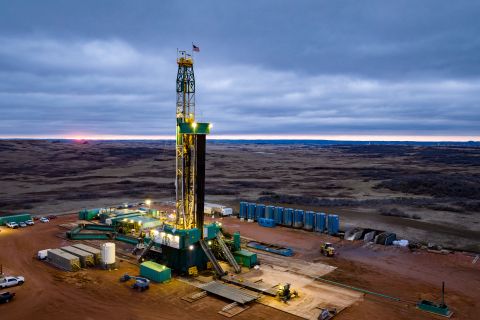U.S. shale oil producers are returning to existing wells and giving them a second, high-pressure blast to lift output for a fraction of the cost of a finishing a new well.
These "refracs" are taking hold as shale oil producers look to take advantage of $100 a barrel crude without making big investments in new wells and fields.
A global oil shortage has triggered calls from U.S. President Joe Biden for shale producers to spend more of their profits on increasing output. But shale firms have been under pressure for years from shareholders to focus on returns rather than production growth.
Their reluctance to invest in more output has led to tensions between the oil industry and the White House, which is under pressure to rein in record $5 per gallon fuel prices that have contributed to decades-high inflation.
Refracking can be something of a booster shot for producers – a quick increase in output for smaller investment than a new well. While some producers have dabbled in refracturing wells in the past, the technique is winning broader adoption as technology improves, aging oilfields erode output, and companies try to do more with less.
Shortages of steel, diesel, frac sand and workers have doubled oilfield inflation since January, making this discount method of boosting output even more attractive.
A refrac can be up to 40% cheaper than a new well, according to experts. More importantly, it can double or triple oil flows from aging wells, said Garrett Fowler, CEO of ResFrac, which helps producers optimize the technique. His firm has seen about twice as many inquiries related to refracs compared to prior years.
For oil producers, refracs are a cheap way to add output to existing pipelines. Their shorter completion time means refracs can be scheduled between work on new wells, said Catherine Oster, who manages Devon Energy's mid-continent properties.
"You go back and find where you maybe under-completed and under-fracked in the beginning," said Oster. Besides, "we’ve made the infrastructure investment. As you learn about your resource, you get those technical learnings" that help decide which wells will benefit from a second shot, she said.
How refrac works
The most common refrac method involves placing a steel liner inside the original well bore and then blasting holes through the steel casing to access the reservoir. In some cases, the process uses half as much steel and frac sand than a new well, said ResFrac's Fowler.
U.S. oil production remains about 1 MMbbl/d below the 12.8 MMbbl/d peak in early 2020. Limiting output is the rapid decline rate of shale wells, which can see production fall by 70% in their first nine months. Flat spending could restrain output to current levels.
While U.S. oil futures are around $104 per barrel, up 40% from a year ago, production costs are higher on material and labor shortages. Some producers are holding back new spending over fears of a recession.
Drill pipe, labor and frac sand costs have driven drilling and well-completion service costs about 20% higher from a year ago, Texas shale producer Callon Petroleum said this month.
Callon and Hess Corp., which drills in North Dakota's Bakken shale, recently hiked capital spending budgets over the costs. Hess added $200 million to its spending, half due to inflation, while Callon added about $75 million.
"Techniques like refracturing will allow the industry to continue to harvest the oil and gas out of these reservoirs," said Stephen Ingram, a regional vice president at top U.S. hydraulic fracturing firm Halliburton.
Another benefit, say oil service executives, is refracs do not require additional state permits or new negotiations with landowners. The disruption to the environment also is less because well sites will already have road access, they said.
"Considering inflation, supply chain issues and rising wages, now is a great time for operators to start looking at wells for refrac opportunities," said Matt Johnson, CEO of energy consultancy Primary Vision Network.
Recommended Reading
Smart Tech Moves to the Hazardous Frontlines of Drilling
2024-10-08 - In the quest for efficiency and safety, companies such as Caterpillar are harnessing smart technology on drilling rigs to create a suite of technology that can interface old and new equipment.
E&P Highlights: Sept. 16, 2024
2024-09-16 - Here’s a roundup of the latest E&P headlines, with an update on Hurricane Francine and a major contract between Saipem and QatarEnergy.
E&P Highlights: Sept. 23, 2024
2024-09-23 - Here's a roundup of the latest E&P headlines, including Turkey receiving its first floating LNG platform and a partnership between SLB and Aramco.
E&P Highlights: Nov. 4, 2024
2024-11-05 - Here’s a roundup of the latest E&P headlines, including a major development in Brazil coming online and a large contract in Saudi Arabia.
Navigating the Crossroads: Oil, Gas Industry Reimagines its Role in Tech Age
2024-10-28 - The oil and gas industry has both a need and an opportunity to embrace the digital transformation while engaging the next generation of its workforce.
Comments
Add new comment
This conversation is moderated according to Hart Energy community rules. Please read the rules before joining the discussion. If you’re experiencing any technical problems, please contact our customer care team.




